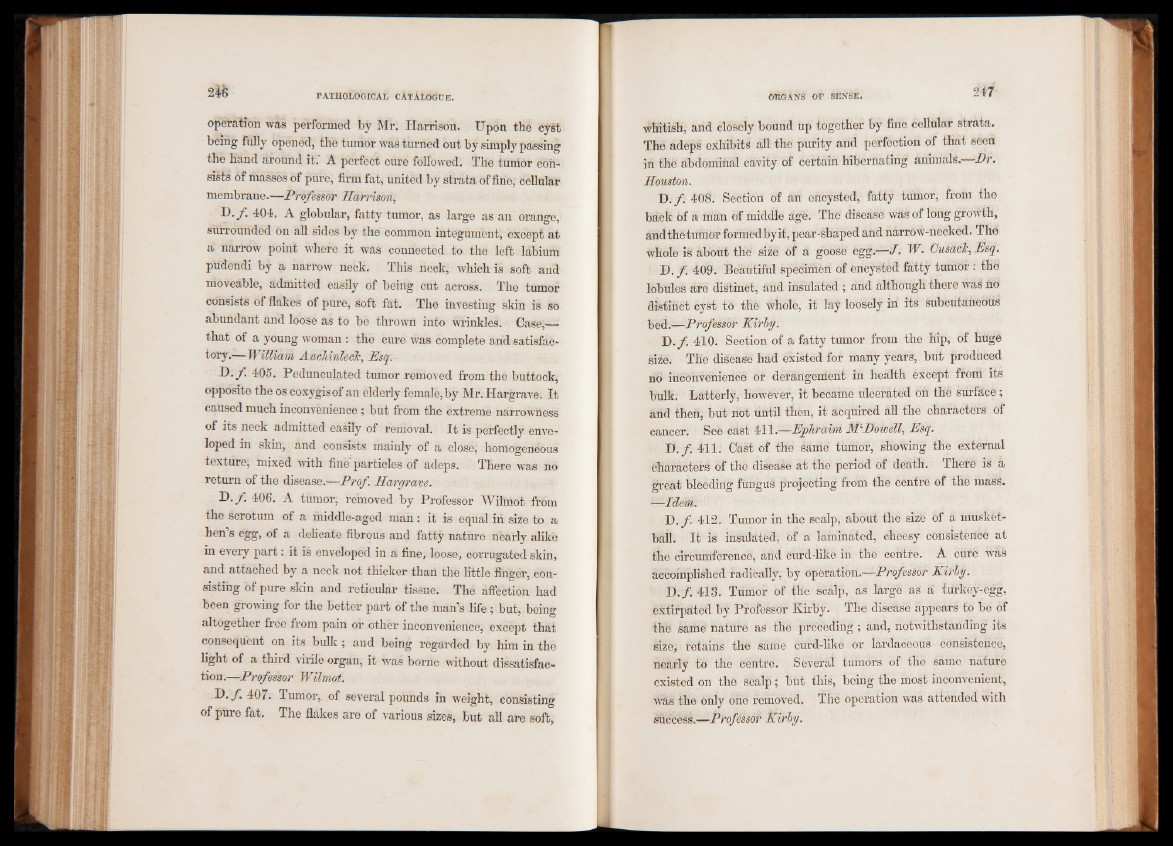
operation was performed by Mr. Harrison. Upon the cyst
being fully opened, the tumor was turned out by simply passing
the hand around it.' A perfect cure followed. The tunior consists
of masses of pure, firm fat, united by strata of fine, cellular
membrane.—Professor Harrison,
D. ƒ. 404. A globular, fatty tumor, as large as an orange,
surrounded on all sides by the common integument, except at
a narrow point where it was connected to the left labium
pudendi by a narrow neck. This neck, which is soft and
moveable, admitted easily of being cut across. The tumor
consists of flakes of pure, soft fat. The investing skin is So
abundant and loose as to be thrown into wrinkles. Case,—
that of a young woman : the cure was complete and satisfactory.—
William AucMnleck, Esq.
D. ƒ. 405. Pedunculated tumor removed from the buttock,
opposite the os coxygisof an elderly female, by Mr. Hargrave. It
caused much inconvenience; but from the extreme narrowness
of its neck admitted easily of removal. It is perfectly enveloped
in skin, and consists mainly of a close; homogeneous
texture, mixed with fine particles of adeps. There was no
return of the disease.—Prof. Hargrave.
I >•/• 406. A tumor, removed by Professor Wilmot from
the scrotum of a middle-aged man: it is equal in size to a
hen’s egg, of a delicate fibrous and fatty nature nearly alike
in every part: it is enveloped in a fine, loose, corrugated skin,
and attached by a neck not thicker than the little finger, consisting
of pure skin and reticular tissue. The affection had
been growing for the better part of the man’s life ; but, being
altogether free from pain or other inconvenience, except that
consequent on its bulk; and being regarded by him in the
light of a third virile organ, it was borne without dissatisfaction.—
Professor Wilmot.
I). f. 407. Tumor, of several pounds in weight, consisting
of pure fat. The flakes are of various sizes, but all are soft,
whitish, arid closely bound up together by fine cellular strata.
The adeps exhibits all the purity and perfection of that seen
in the abdomirial cavity of certain hibernating animals. Dr.
Houston.
D. ƒ. 408. Section of an encysted, fatty tumor, from the
back of a man of middle agè. The disease was of long growth,
and the tumor formedbyit, pear-shaped and narrow-necked. The
whole is about the size Of a goose egg.—J . W. Cusack, Esq.
D. f. 409. Beautiful speciriien of encysted fatty tumor : the
lobules afe distinct, and insulated; and although there was no
distinct cyst to the whole, it lay loosely in its subcutaneous
bed.—Professor Kirby.
D. ƒ. 410. Section of a fatty tumor from the hip, of huge
size. The disease had existed for many years,, but produced
no inconvenience or derangement in health except from its
bulk. Latterly, however, it became ulcerated on thé surface;
and theri, but not until then, it acquired all the characters of
cancer. See cast 411.—Epliraim ]HiDoioell, Esq.
Tf.f. 411. Oast of the same tumor, showing the external
characters of the disease at the period of death. There is a
great bleeding fungus projecting from the centre of the mass.
—Idem.
D. f 412. Tumor in the scalp, about the size of a musket-
ball. It is insulated, öf a, laminated, cheesy consistence at
the circumference, and Curd-like in the centre. A cure was
accomplished radically, by operation.—-Professor Kirby.
D. ƒ. 413. Tumor of tlie scalp, as large as a turkey-egg,
extirpated by Professor Kirby. The disease appears to be of
the same nature as the preceding; and, notwithstanding its
size, retains the same curd-like or lardaceous consistence,
nearly to the centre. Several tumors of the same nature
existed on the scalp; but this, being the most inconvenient,
was the only one removed. The operation was attended with
success.—Professor Kirby.